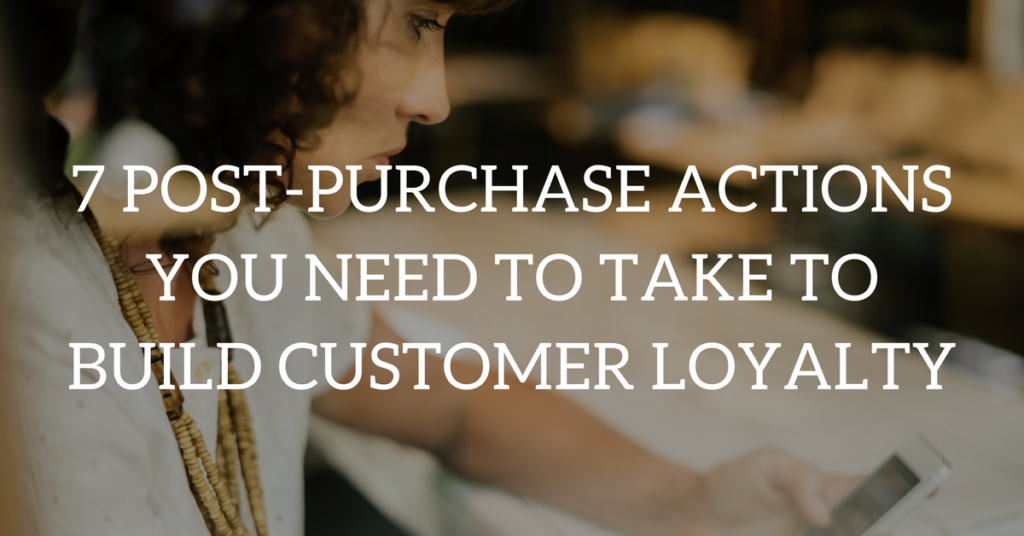Savvy business owners know that customer retention is worth its weight in gold. The numbers say it all: it costs five times more to bring in a new customer than it does to maintain a current one and the odds of making a sale to a current customer are 60-70 percent compared to only a 5-20 percent chance of selling to a new lead.
That’s why you need to develop post-purchase strategies: in order to enhance customer loyalty and drive revenue. While many businesses tend to focus their efforts on pre-purchase marketing, solid post-purchase tactics can extend the effects of your hard-won sales and keep the retail ball rolling.
Have you enrolled customers who just made a purchase in your brand’s loyalty program? Maybe, you send them surveys to find out what they’re really thinking? Or send out celebratory confirmation messages that make them feel good about their purchases?
Those are some of the ways you can enhance your business’ relationship with a customer who just bought something from you. Let’s see how you can continue engaging your customers after a purchase:
1. Ask for a product review
Asking a customer to write a product review for you can help reinforce your relationship with them. First, it forces your clients to really analyze your product and their satisfaction with it. Second, it lets them know you have confidence in your product and aren’t afraid to ask people for reviews.
As a reward for leaving a review, you can offer a discount on future purchases or a reward unrelated to your store such as a gift card. Your tone should be encouraging and appreciative: Inviting them to leave a review and thank them for helping you to improve your product by expressing their honest opinion.
Remember: Customers who leave positive reviews are more likely to become brand advocates.
2. Send branded confirmations
Remember that each step of the purchasing process is an opportunity for you to reinforce your brand’s message and style to the customer. Imagine receiving an exciting offer from your favorite brand that makes you rush to click on their site and make a purchase. Then imagine how all this effort and excitement could fall flat when you receive a dull automated purchase/shipping confirmation.
Many people feel a rush after making a new online purchase and look forward to receiving their package in the mail. You can amp up this enthusiasm with a confirmation that includes a positive message, congratulating them on making the purchase and an image that matches your brand’s style. Make them feel good about their purchase and helps them identify more strongly with your brand.
Here is an example of nice branded shipping confirmation:
3. Invite to your loyalty program
Loyalty programs work to boost sales and keep your hard-earned customers coming back to you instead of going to your competition. According to the 2016 Bond Loyalty Report, 81 percent of customers say they are more likely to keep shopping with a brand that offers a loyalty program. Offering a discount to a customer for joining your loyalty club after they’ve made a purchase is a great way to give them incentive to join the club.
After that, it’s up to you to send them well-crafted messages with the benefits they like and the VIP treatment they deserve. Here’s how to ace your loyalty program:
Personalize – As our ability to hone in on relevant customer data increases, so does our ability to market targeted offers to customers. More and more, customers expect all brands to know what they like and to send them offers that are of value to them.
Diversify your channels – Customers today use a wide variety of platforms to interact with brands so it makes sense to offer them different ways to be loyal to them. Email, SMS, mobile apps, and social media can all be used to send promotions to customers. 88 percent of marketers say that coordinating multichannel campaigns is important to managing loyalty clubs.
By including different platforms, you’re also giving customers a choice about where they prefer to engage with you. Make sure that each platform sends out unique offers – For example, if a customer is a member of your email loyalty program, send them offers that are just for email customers that Facebook or SMS club members don’t have access to.
This will give your customers the incentive to sign up for more platforms, giving you more ways to reach them and upping your chances of completing new sales with them.
In the case of Julep, a subscription beauty company, running a “Mobile Insider Club” led to 5,000 new subscribers within a first day of the campaign and 99% of those subscribers stay in that loyalty club:
4. Run a post-purchase survey
There are lots of ways to get information about your clients. Today you can pull information about their purchase history, preferences, demographics, social media habits, and more. But there’s nothing like picking a customer’s brain with a survey for you to get to the bottom of what makes them tick.
A survey accomplishes a lot of things. It gives customers a way to express themselves to you, which is exactly what you want, especially if the purchase experience wasn’t great. Did you know that a dissatisfied customer is likely to tell an average of 8-10 people about a bad experience? By asking them how it went, you show them that you care and give them a productive place to share their criticisms (instead of on review sites or social media) as well as giving you a chance to correct your error if you made one.
Surveys also allow you to find out directly from the customer what they like and dislike about your brand, what types of products or services they would like to see in the future and what they would change about the purchase process, if anything.
5. Take advantage of social media
Adding social media to your communication with your customers is a step closer to customer retention. In fact, 44 percent of retailers say that social media drives customer retention. Reach out to the customers on your email list and give them an incentive to opt-in to your social media program by offering a promotion or running a contest.
Adventure travel company The Clymb ran a contest through Twitter and Facebook, enhancing connection with their existing clients, gaining greater exposure and even new clients.
Social media also provides customers with a platform to express their enthusiasm and interactions with your brand. Encourage your customers to post on social media by offering rewards and discounts. That way you can expect higher engagement as 84 percent of customers would be willing to spend more with brands that reward them for social media posts.
The best thing about social media is the sharing aspect – converting one customer and getting them to post will lead to exposure of your brand to their entire friend’s list and beyond as customers share and repost photos, testimonials and videos.
6. Purchase anniversary offers
This tactic really focuses on extending the purchase experience for the long-term. Sending a 1-year purchase anniversary message with a discount on a related item or an offer to re-purchase can be an effective way to get customers to buy.
If the customer bought a computer, you can send an offer for a printer or a computer case or see if they’re ready for an upgrade. Use a tone that celebrates your relationship with the client. Something like this…
.. Or this
7. Upsell
When a customer makes a new purchase with you, it gives you new insight into their current lifestyle and preferences. For example, if they just bought a neck massager, you can assume they’re looking for the best way to relax their muscles. Sending them a promotion for a massage chair can get them thinking: The neck massager they bought is great, but a massage chair would be even more effective.
Identify the preference and need they expressed with their purchase and offer the top of the line product you have to fulfill that need by focusing on the quality of experience they can have with the better product.
Brian Carter, a digital marketing guru and founder of Brian Carter Group confirms that upselling helps to build customer relationships with your brand:
“Do you have a next step for them when they’re done with what you’re helping them with now? Do you have another upsell? How else can you help them? Develop more products and services and show them how they can go further. In B2C it’s about furthering or deepening the experience.”
Here is an example of post-purchase email from SaleCycle:
By incorporating these post-purchase tactics into your sales and marketing strategy, your ecommerce business can enhance customer loyalty and improve revenue. Have you tried any of them? Or maybe you have your own post-purchase tactics? Share in comments!












5 thoughts on “7 Post-Purchase Actions You Need to Take to Build Customer Loyalty”
All these points are highly actionable but have you ever experienced customer complaining about these series of post purchase actions? I mean, I have seen customer may not like these series of followups and sometime they annoy.
Share your experience!
I can’t speak for Alexa – but I find that the amount of complaints is a lot less than the amount of success.
That is interesting to know. Nice meeting your virtually William. I am working on one topic related to social commerce. Let me know if you want to see the same.
Such a bad design – your share tab covers the post text !
Oh man – I’m sorry to hear that. We use Sumo to power the share bar and it works wonderfully on every device I’m using. Can you tell me more about what device, aspect ratio, etc. so I can figure out why it looks like that for you?